
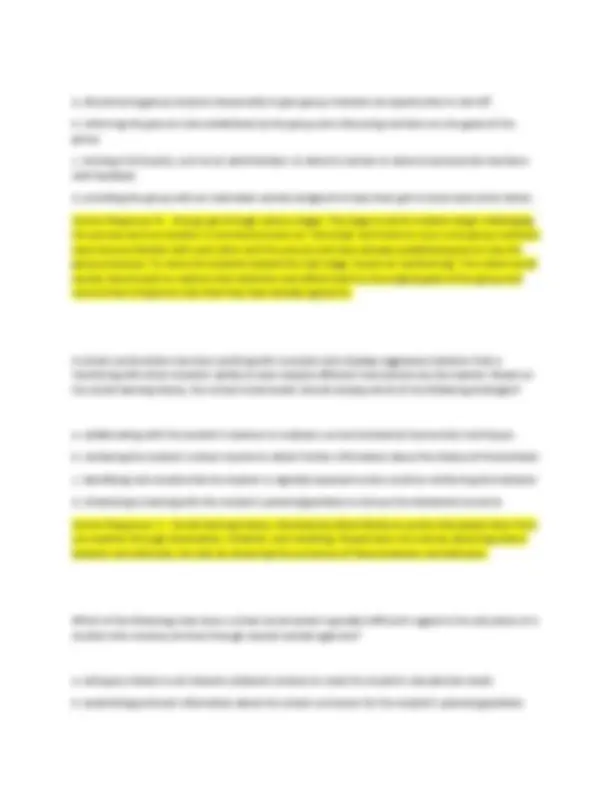
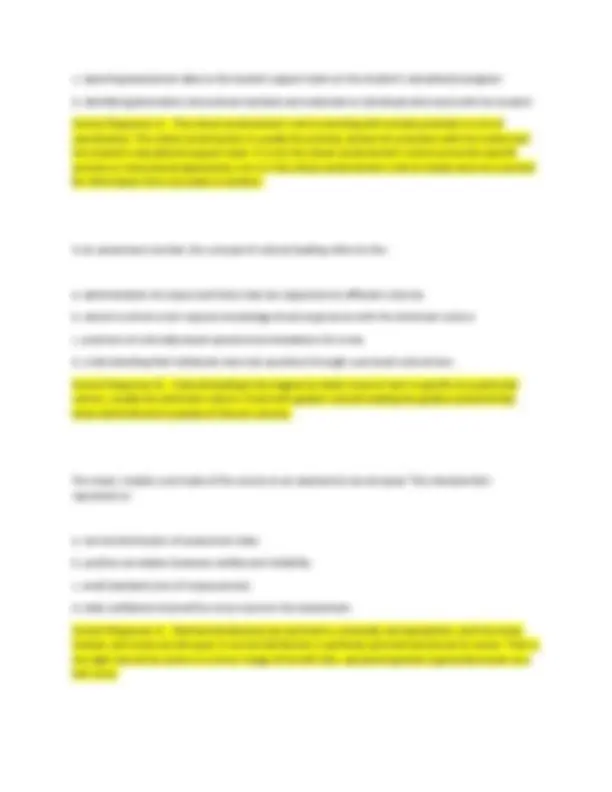
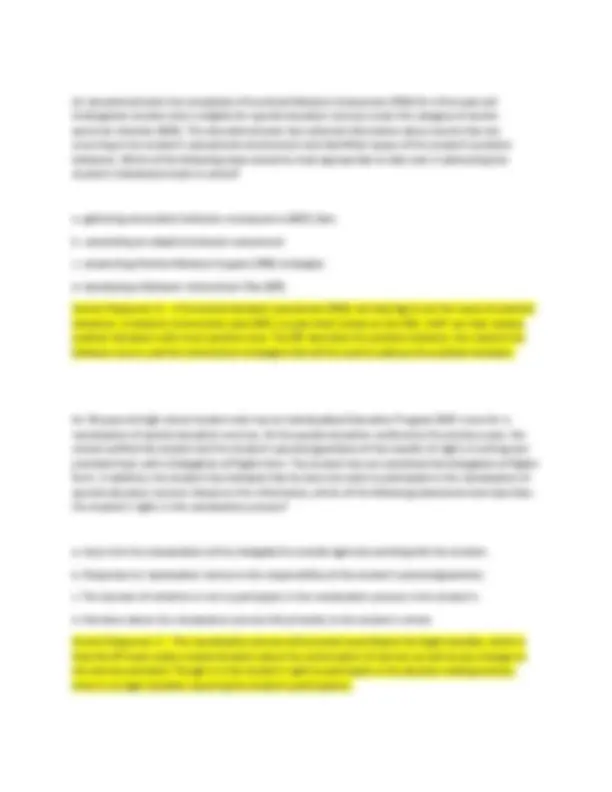
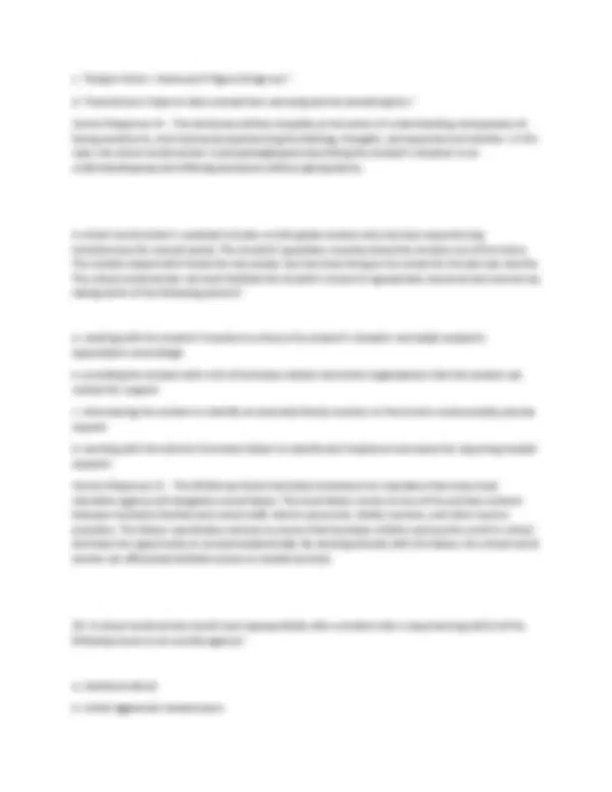
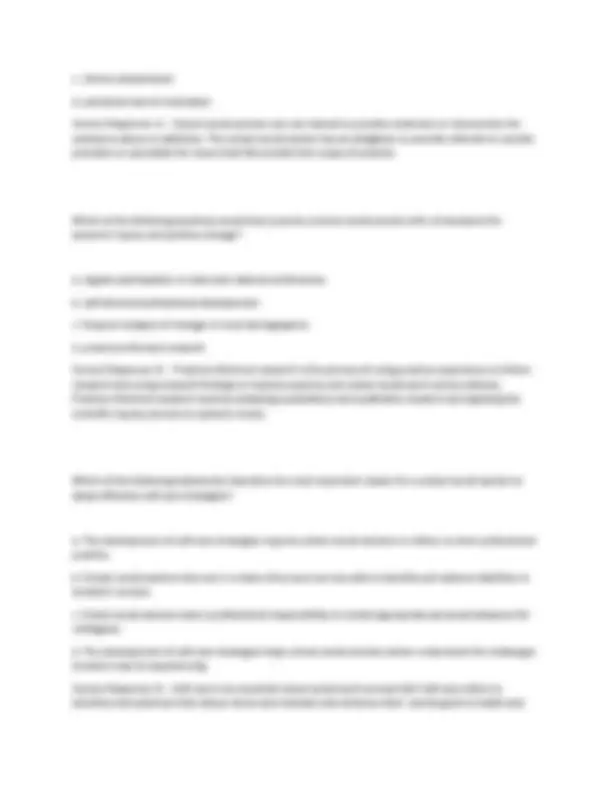



Study with the several resources on Docsity

Earn points by helping other students or get them with a premium plan


Prepare for your exams
Study with the several resources on Docsity

Earn points to download
Earn points by helping other students or get them with a premium plan
Community
Ask the community for help and clear up your study doubts
Discover the best universities in your country according to Docsity users
Free resources
Download our free guides on studying techniques, anxiety management strategies, and thesis advice from Docsity tutors
A series of multiple-choice questions and answers related to key concepts and practices in school social work. It covers topics such as practical intelligence, identity development, second-language acquisition, anxiety interventions, group dynamics, social learning theory, collaboration with outside agencies, cultural loading in assessments, data distribution, functional behavior assessments, and individualized education programs. The questions and answers provide insights into the role and responsibilities of school social workers in supporting students' academic, social, and emotional well-being.
Typology: Exams
1 / 10

This page cannot be seen from the preview
Don't miss anything!







Which of the following students is most clearly demonstrating strength in the area of practical intelligence? a. Sanjay experiments with different textures and patterns during a painting unit in art class. b. Ahna systematically observes how different variables affect plant growth for a science experiment. c. Jason takes detailed notes during instruction and highlights important vocabulary in his notes. d. Yolanda applies geometry and measurement concepts to construct a scale model of the school. Correct Response: D. - Robert J. Sternberg proposes three intelligences in human cognition. Practical intelligence is defined as how well a person can apply the analytic intelligence (i.e., ability to process information and solve problems) they possess in many different situations. Students who attend schools where teachers and staff reflect students' cultural and racial characteristics generally experience enhanced: a. identity development. b. social interactions. c. peer relationships. d. self-management skills. Correct Response: A. - Identity formation is a process that takes many years and role models are crucial in the formation of identity. When students have the opportunity to have role models who share their racial, cultural, and linguistic characteristics, they are better able to work through the process of identity formation. Which of the following elements of the educational environment is most essential in supporting second- language acquisition?
a. regular, structured opportunities to recite new vocabulary in the second language b. ongoing feedback on appropriate pronunciation and syntax in the second language c. frequent, multisensory exposure to comprehensible input in the second language d. explicit instruction in the grammar and mechanics of the second language Correct Response: C. - Input is language that the student either hears or reads that aims at communicating something. For input to promote second-language learning, it must be comprehensible. Comprehensible input allows students to figure things out by themselves using the context and background provided. When students can understand the meaning of some words but can't interpret others, the knowledge of the background or context can point them in the direction of the unknown words. Over time, students will become adept at using these techniques to interpret words by themselves, which broadens their understanding of the target language. A school social worker will be providing individual counseling for a fourth-grade student with generalized anxiety disorder. The student performs slightly above grade level, but consistently demonstrates undue concern and fretting behaviors related to school assignments and assessments, including hypervigilance about due dates, grades, and work quality. Appropriate interventions for this student should include which of the following elements? a. working with the student's teachers to increase their use of ungraded learning tasks b. helping the student develop concrete strategies for coping with key stressors c. instituting daily check-ins with a teacher for the student to review progress d. enhancing the student's ability to communicate concerns effectively Correct Response: B. - Coping strategies, such as deep breathing and exercise, are commonly used to address the symptoms of anxiety. Concrete coping strategies that are directly related to the anxiety- causing issues provide the individual with tools to use that can help minimize feelings of anxiety. For example, keeping a calendar and using rubrics are two strategies for addressing anxiety related to due dates and work quality. Which of the following approaches would be most appropriate for a school social worker to emphasize when members of a small group begin having disagreements and challenging the process during sessions?
c. reporting assessment data to the student support team on the student's educational progress d. identifying alternative instructional methods and materials to individuals who work with the student Correct Response: A. - The school social worker's role in working with outside providers is one of coordination. The school social worker is usually the primary contact for providers with the school and the student's educational support team. It is not the school social worker's role to prescribe specific services or instructional approaches, nor is it the school social worker's role to simply serve as a conduit for information from one party to another. In an assessment context, the concept of cultural loading refers to the: a. administration of unique test forms that are responsive to different cultures. b. extent to which a test requires knowledge of and experience with the dominant culture. c. provision of culturally based special accommodations for a test. d. understanding that individuals view test questions through a personal cultural lens. Correct Response: B. - Cultural loading is the degree to which a test or item is specific to a particular culture, usually the dominant culture. A test with greater cultural loading has greater potential bias when administered to people of diverse cultures. The mean, median, and mode of the scores on an assessment are all equal. This characteristic represents a: a. normal distribution of assessment data. b. positive correlation between validity and reliability. c. small standard error of measurement. d. wide confidence interval for a true score on the assessment. Correct Response: A. - Normal distributions are symmetric, unimodal, and asymptotic, and the mean, median, and mode are all equal. A normal distribution is perfectly symmetrical around its center. That is, the right side of the center is a mirror image of the left side, representing what is generally known as a bell curve.
An educational team has completed a Functional Behavior Assessment (FBA) for a five-year-old kindergarten student who is eligible for special education services under the category of autism spectrum disorder (ASD). The educational team has collected information about events that are occurring in the student's educational environment and identified causes of the student's problem behaviors. Which of the following steps would be most appropriate to take next in addressing the student's behavioral needs in school? a. gathering antecedent-behavior-consequence (ABC) data b. completing an adaptive behavior assessment c. researching Positive Behavior Support (PBS) strategies d. developing a Behavior Intervention Plan (BIP) Correct Response: D. - A functional behavior assessment (FBA) can help figure out the cause of problem behaviors. A behavior intervention plan (BIP) is a plan that's based on the FBA. A BIP can help replace problem behaviors with more positive ones. The BIP describes the problem behavior, the reasons the behavior occurs, and the intervention strategies that will be used to address the problem behavior. An 18-year-old high school student who has an Individualized Education Program (IEP) is due for a reevaluation of special education services. At the special education conference the previous year, the school notified the student and the student's parents/guardians of the transfer of rights in writing and provided them with a Delegation of Rights form. The student has not submitted the Delegation of Rights form. In addition, the student has indicated that he does not want to participate in the reevaluation of special education services. Based on this information, which of the following statements best describes the student's rights in the reevaluation process? a. Input into the reevaluation will be delegated to outside agencies working with the student. b. Responses to reevaluation notices is the responsibility of the student's parents/guardians. c. The decision of whether or not to participate in the reevaluation process is the student's. d. Decisions about the reevaluation process fall primarily to the student's school. Correct Response: C. - The reevaluation process will proceed according to the legal mandate, which is that the IEP team makes a determination about the continuation of services as well as any changes to the services provided. Though it is the student's right to participate in the decision-making process, there is no legal mandate requiring the student's participation.
a. learning about the roles and functions of school personnel and how the school currently makes decisions b. analyzing the results of previous family and staff surveys about current school programs and services c. conducting observations in various areas of the school to assess the overall school climate d. working with interested staff and other stakeholders to revise the school's vision and mission statements Correct Response: A. - A school is a system in which various individuals play different roles and have different functions in implementing the school's mission and programs. It is important for the school social worker to know first what these roles and functions are in order to effectively advocate for and implement changes to the system. A school social worker can best promote effective utilization of school social work services by taking which of the following actions? a. digitizing the process of submitting referrals for and accessing social work services b. distributing weekly fact sheets to staff spotlighting a specific social work service and its role in the school environment c. working with other social workers to centralize procedures for requesting services at the district level d. ensuring that members of the school community have a clear understanding of available social work services and how to access them Correct Response: D. - School social work services should be tailored to the needs of the specific school population and community. Members of the school community will be unable to make effective use of services unless they understand what services are available and how to request or access the services they need. Needs may go unaddressed without adequate knowledge in these areas. A high school junior tells the school social worker that he is feeling stressed by all of the decisions facing him as he leaves high school and prepares for college. The student cites college entrance exams, financial worries, upcoming senior projects, and part-time employment. Which of the following responses to the student's concerns by the social worker best illustrates the use of empathy? a. "I'm sorry to hear this. Have you talked to your parents?" b. "It sounds like you have a lot going on. Is there anything I can do to help?"
c. "Hang in there. I know you'll figure things out." d. "Sometimes it helps to take a break from worrying and do something fun." Correct Response: B. - The dictionary defines empathy as the action of understanding, being aware of, being sensitive to, and vicariously experiencing the feelings, thoughts, and experience of another. In this case, the school social worker is acknowledging and describing the student's situation in an understanding way and offering assistance without giving advice. A school social worker's caseload includes a ninth-grade student who has been experiencing homelessness for several weeks. The students' guardians recently kicked the student out of the home. The student stayed with friends for two weeks, but has been living on the street for the last two months. The school social worker can best facilitate the student's access to appropriate resources and services by taking which of the following actions? a. meeting with the student's teachers to discuss the student's situation and adapt academic expectations accordingly b. providing the student with a list of homeless shelters and other organizations that the student can contact for support c. interviewing the student to identify an extended family member or friend who could possibly provide support d. working with the district's homeless liaison to identify and implement processes for acquiring needed supports Correct Response: D. - The McKinney-Vento Homeless Assistance Act stipulates that every local education agency will designate a local liaison. The local liaison serves as one of the primary contacts between homeless families and school staff, district personnel, shelter workers, and other service providers. The liaison coordinates services to ensure that homeless children and youths enroll in school and have the opportunity to succeed academically. By working directly with the liaison, the school social worker can effectively facilitate access to needed services.
well-being when used on a regular basis. Self-care is necessary to prevent burnout and to help ensure effectiveness and success in honoring professional commitment to high-quality and responsive services.